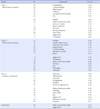Abstract
Purpose
This study was done to identify types and characteristics of gender role identity from the perspectives of nursing students who experience challenges and maladjustments that are distinct from students in other departments because nursing students have a curriculum that includes both academic courses and clinical practice.
Methods
Q Methodology was used to examine differences in the meaning of gender role identity among individual students. Data from 40 women nursing students, using 40 Q samples representing masculinity and femininity, were collected and analyzed.
Results
The participants' responses were classified into three types: 'Affectionate-sensitive type' represented by those who share traditional Korean feminine characteristics and are delicately sensitive. 'Affectionate-assertive type' represented by those who have strong characteristics of warm leaders, and are responsive and confident. 'Sensitive-expressive type' represented by those who are excellent in communication and have high empathic ability.
Figures and Tables
References
1. Kim MA, Nam SH. A Q study on gender-role identity among college students. J Korean Acad Adult Nurs. 2004; 16(2):306–315.
2. Shim MH, Endo Y. A research on gender-role identity, gender discriminative consciousness and attitudes toward military service of Korean college students. Korean J Psychol Soc Issues. 2011; 17(1):1–17.
3. Kim HR. The development of gender role identity scale for adolescents. J Soc Res. 2006; 12:135–152.
4. Yang SO, Jeong GH. Perceptional difference of sexual image and sexual role between male and female students in university, Korea. Korean J Women Health Nurs. 2002; 8(2):289–300.

5. Park SK, Jo KM, Joa YK, Kang DW, Lee YJ. A survey on the activities of nurses. Report[Internet]. 2015. Sep. cited 2015 Oct 20. 202p. Available from: https://www.khidi.or.kr/board/view?linkId=158628&menuId=MENU00085.
6. Kim CH, Kang YH, Lee GJ. 2014 higher educational institution graduates and health insurance DB interface employment statistical survey. Report[Internet]. 2014. Dec. cited 2015 Oct 22. Available from: http://kess.kedi.re.kr/publ/view?survSeq=2014&publSeq=17&menuSeq=0&itemCode=02&language=en#.
7. Hospital Nurses Association. 2014 Annual report. Seoul: Hospital Nurses Association;2015. 495p. Available from: http://www.khna.or.kr/bbs/bbs/board.php?bo_table=news&wr_id=11175.
8. Kim MA, Lim JY, Kim SY, Kim EJ, Lee JE, Ko YK. Influencing factors on nursing students' career attitude maturity. J Korean Acad Psychiatr Ment Health Nurs. 2004; 13(4):383–391.
9. Cho H, Lee GY. Self esteem and career identity of nursing students. J Korean Acad Public Health Nurs. 2006; 20(2):163–173.
10. Yeun EJ, Kwon HJ, Kim HJ. Subjectivity of nursing college students' awareness of gender equality: An application of Qmethodology. J Korean Acad Nurs. 2012; 42(3):342–350. DOI: 10.4040/jkan.2012.42.3.342.

11. Choi IS. Relations among school adjustment behaviors, academic achievement, gender-role identity, and learning style in college students. J Humanit Stud. 2007; 34(2):547–573.
12. Kim EH, Kim BW. A study on the career search self-efficacy and career preparation behavior by gender role identity. J Vocat Educ Res. 2010; 29(4):165–183.
13. Kim HW. Relationships between sex role identity, health promoting behaviors, and premenstrual symptoms among female university students. J Korean Acad Nurs. 2007; 37(6):1003–1012.

14. Ryu EJ, Seo JS, Ham MY, Park YR, Moon SW. Sex-role identity in adolescents and its relation to anxiety, depression and suicidal ideation. J Korean Acad Psychiatr Ment Health Nurs. 2006; 15(2):136–143.
15. Park EA. Gender role identity of female college students and the diversity of its types. Korean J Adult Nurs. 2011; 23(5):423–433.
16. Kim MA, Ko SH, Park EA. Understanding the gender role identity in male nursing students. J Korean Acad Soc Nurs Educ. 2014; 20(2):223–233. DOI: 10.5977/jkasne.2014.20.2.223.

17. Kim HK. Q methodology: philosophy, theories, analysis, and application. Seoul: Communication books;2008. p. 512.
18. Park EA, Ko SH, Kim MA. Understanding the gender role identity among adolescent male. J Korean Soc Sci Study Subj. 2011; 22:147–160.
19. ten Hoeve Y, Jansen G, Roodbol P. The nursing profession: public image, self-concept and professional identity. A discussion paper. J Adv Nurs. 2014; 70(2):295–309. DOI: 10.1111/jan.12177.

20. Kim J, Lee H, Kim M. Structural components of leadership perceived by head nurses. J Korean Acad Nurs Adm. 2005; 11(3):1–16.
21. Muldoon OT, Reilly J. Career choice in nursing students: Gendered constructs as psychological barriers. J Adv Nurs. 2003; 43(1):93–100. DOI: 10.1046/j.1365-2648.2003.02676.x.

22. Park Y, Shim HI, Lee SJ. Cultural characteristics of Korean interpersonal relationships and scale development-affective relationship. Korean J Cult Soc Issues. 2014; 20(4):415–441.
23. Kim AJ, Choi YH. The construct of caring concept perceived by patients in nurse-client interaction. Korean J Adult Nurs. 1990; 2(1):52–74.
24. Begum S, Slavin H. Perceptions of "caring" in nursing education by Pakistani nursing students: An exploratory study. Nurs Educ Today. 2012; 32(2012):332–336. DOI: 10.1016/j.nedt.2011.10.011.

25. Lee KE, Ha JY. Personality types and learning styles of female students in health-related science major. Korean J Womens Health. 2011; 12(1):117–135.
26. Oh BY, Lee SH. The difference in career attitude maturity, self-esteem, depression and college adjustment between vocational identity status: focused on the vocational identity status assessment (VISA). In : Proceedings of the Korean Psychological Association Annual Conference; 2013 August 23; Deajeon, Korea. Deajeon (Korea): Incruit;2013. p. 274.
27. Gupta A, Chong S, Leong FTL. Development and validation of the vocational identity measure. J Career Assess. 2015; 23(1):79–90. DOI: 10.1177/1069072714523088.

28. Park HS, Kim MK. The effect of counselor's sex role identity on working alliance. Korean J East West Mind Sci. 2005; 8(1):31–43.
29. Farrell GA. Aggression in clinical settings: nurses' view-a follow-up study. J Adv Nurs. 1999; 29(3):532–541. DOI: 10.1046/j.1365-2648.1999.00920.x.
30. Mackay I, Paterson B, Cassells C. Constant or special observations of inpatients presenting a risk of aggression or violence: nurses' perceptions of the rules of engagement. J Psychiatr Ment Health Nurs. 2005; 12(4):464–471. DOI: 10.1111/j.1365-2850.2005.00867.x.





 PDF
PDF ePub
ePub Citation
Citation Print
Print




 XML Download
XML Download